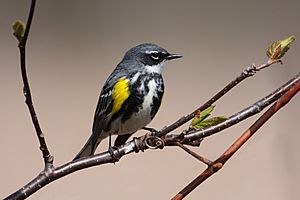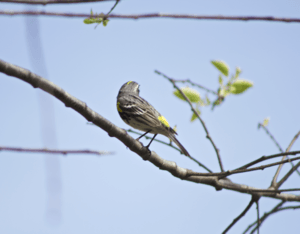Myrtle warbler facts for kids
Quick facts for kids Myrtle warbler |
|
|---|---|
 |
|
| Scientific classification |
|
| Kingdom: | Animalia |
| Phylum: | Chordata |
| Class: | Aves |
| Order: | Passeriformes |
| Family: | Parulidae |
| Genus: | Setophaga |
| Species: | |
| Subspecies: |
S. c. coronata
|
| Trinomial name | |
| Setophaga coronata coronata (Linnaeus, 1766)
|
|
| Synonyms | |
|
|
The myrtle warbler (Setophaga coronata coronata) is a small, active songbird. It is a type of New World warbler. These birds are known for their bright yellow patches. They are often seen flitting through trees and bushes.
Contents
Where Myrtle Warblers Live
Myrtle warblers live in many parts of Canada and the northeastern USA. They prefer areas further east than their close relatives, Audubon's warblers.
Myrtle Warbler Migration
These birds are migratory. This means they travel long distances between seasons. They spend their summers breeding in the north. When winter comes, they fly south. They winter in the southeastern United States, eastern Central America, and the Caribbean. Sometimes, a few brave birds even fly across the ocean. They have been seen as rare visitors in western Europe, and some have spent the winter in Great Britain.
What Myrtle Warblers Look Like
Myrtle warblers are easy to spot with their bright colors.
Male and Female Differences
- Summer Male: The male myrtle warbler in summer has a beautiful slate blue back. It has bright yellow patches on its crown, rump, and sides. Its tail has white patches. The chest has black streaks.
- Female: The female looks similar to the male. However, her back is brown instead of blue. Her chest streaks are also brown.
How to Tell Them Apart
It can be tricky to tell myrtle warblers from their close relatives, Audubon's warbler. Here are some clues:
- Myrtle warblers have a whitish stripe above their eye.
- Their throat is white, not yellow.
- They have a clear, contrasting cheek patch.
Myrtle Warbler Sounds
Myrtle warblers have a distinct song and call.
Their Song
Their song is a trill-like sound. It often sounds like "tyew-tyew-tyew-tyew." Sometimes, they add three more "tew" sounds at the end. It is very similar to the song of Audubon's warbler.
Their Call
Their call is a short, sharp sound. It sounds like a hard check.
Myrtle Warbler Habitat and Nesting
Myrtle warblers like to live in different kinds of forests.
Where They Live
Their favorite places are coniferous (like pine or spruce) and mixed woodlands. These are forests with both evergreen and leafy trees.
Building a Nest
Myrtle warblers build their nests in trees. Their nest is shaped like a cup. The female usually lays 4 to 5 eggs in the nest.
What Myrtle Warblers Eat
Myrtle warblers are mostly insectivorous. This means they love to eat insects.
Winter Food
In winter, when insects are harder to find, they change their diet. They will happily eat berries from the wax-myrtle plant. This habit is how the species got its name!
Hunting Style
Experienced bird watchers can often recognize myrtle warblers by how they hunt. They act a bit like flycatchers. They make short flights from their perch to catch bugs in the air. When they migrate or in winter, they often gather in small groups.
Myrtle Warbler Family Tree
Scientists have studied the myrtle warbler for a long time. They know it is closely related to the Audubon's warbler.
Different Classifications
Sometimes, scientists group these two birds as one species. Other times, they are considered two separate species. Currently, in North America, they are officially seen as two types of the same bird: the Yellow-rumped warbler. The myrtle warbler is known as Setophaga coronata coronata. The Audubon's warbler is Setophaga coronata auduboni. These two groups likely became different during the last ice age.


